(Important)
- When operating the OseComm32 utility using a Bluetooth port, operational problems may occur due to starting multiple instances. When using the OseComm32 utility with a Bluetooth port, we recommend using this utility and setting it to Single instance mode.
- When operating the OseComm32 utility on Windows 10's Bluetooth port, a rare problem has been reported in which a communication error occurs. When operating with Windows 10's Bluetooth port, we recommend enabling the Bluetooth automatic recovery setting of this utility.
- This utility is compatible with Windows 10. Other OSs are not supported.
By configuring settings with this utility, you can change the behavior of OseComm32 utility as follows.
- You can set the OseComm32 utility to Single instance mode.
By default, multiple OseComm32 utility screens can be opened, but by configuring this utility, you can change to Single instance mode where only one OseComm32 utility is started at the same time.
- Provides the following functions to automatically recover from problems that occur with the Bluetooth port.
- You can automatically restart Windows 10's Bluetooth service and make sure the Bluetooth port is enabled before starting the OseComm32 utility.
- While running the OseComm32 utility, you can monitor the protocol for abnormalities and automatically restart the OseComm32 utility and the Windows 10 Bluetooth service if any abnormalities occur.
Installing the OseComm32Settings utility
If you are using Standard app editor
- Click the Bluetooth icon in Standard app editor.

- Click the “OseComm32 Settings” link.
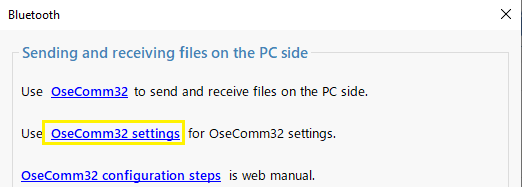
*If you have already installed OseComm32 settings, the OseComm32 settings app will start.
- Click Yes.
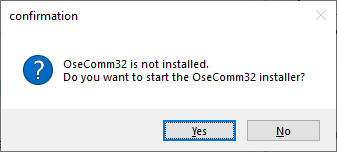
- Follow the installer messages to install.
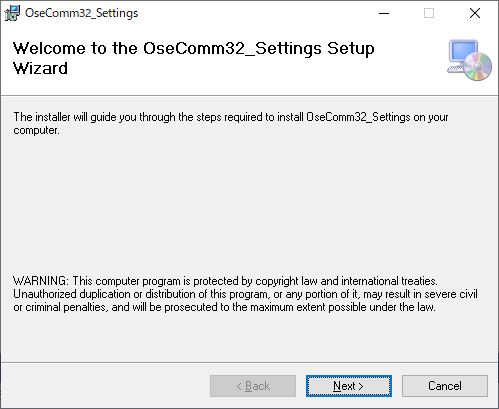
Otherwise
Please install by following the steps in OseComm32Settings utility latest release.
OseComm32Settings utility operations
Select "OseComm32 settings" in the "Opticon" folder in the start menu to start the OseComm32Settings utility and open the screen shown below.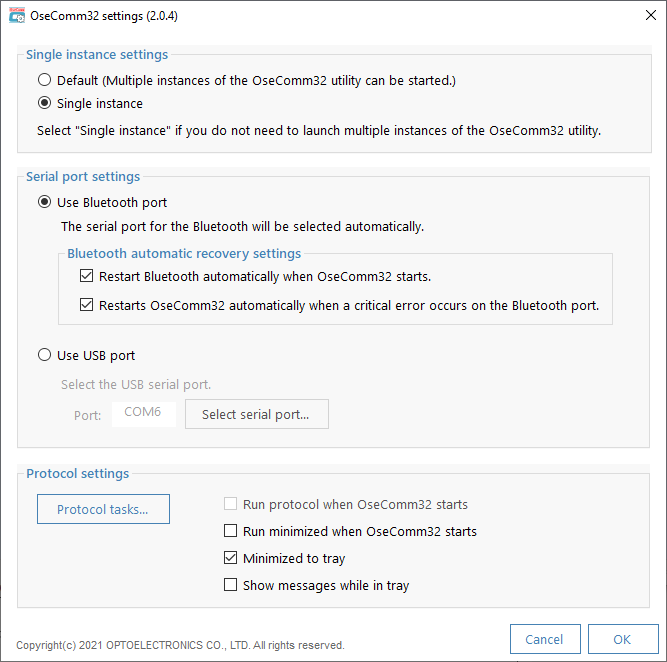
Single instance configuration
- Default:
- Performs the default behavior of the OseComm32 utility. If you do not need to start multiple OseComm32 utilities at the same time, select [Single instance] below to prevent accidental operation.
- Single instance:
- Allows only one OseComm32 utility to be started at a time.
The behavior when you select Single instance is as follows:- When the OseComm32 utility is already running, if you perform an operation to start the OseComm32 utility, the screen of the already running OseComm32 utility will be opened.
- If the OseComm32 utility is already running and you try to start it with a configuration file that is different from the currently open configuration file (.osf), the following confirmation message will be displayed.
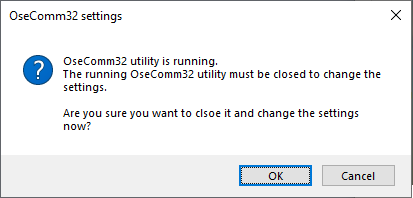
If you press [Yes], the currently running OseComm32 utility will be terminated and a new OseComm32 utility will be started.
Serial port settings
If you select [Bluetooth], you can specify the following "Bluetooth automatic recovery settings" items.- Bluetooth:
- Select when performing Bluetooth communication.
- USB:
- Select when performing USB communication.
- Port:
-
Select the serial port used for USB connection with OPH-5000i.
Automatic recovery setting for Bluetooth
- Automatically restart Bluetooth when starting OseComm32:
- If you enable [Run protocol at startup] in the OseComm32 utility and specify a Bluetooth port as the communication port, when you start the OseComm32 utility, a screen like the one shown below will be displayed and the Bluetooth service will be automatically activated. Restart and make sure the specified Bluetooth port is enabled.

If the specified Bluetooth port is not enabled, check whether other Bluetooth incoming ports are enabled. If the Bluetooth port still does not become enabled, continue to launch the OseComm32 utility. - Automatically restart OseComm32 when a fatal error occurs on the Bluetooth port:
- While the protocol is running on the Bluetooth port, it monitors the protocol for abnormalities and automatically restarts the OseComm32 utility if there is an abnormality.
At this time, if [Automatically restart Bluetooth when OseComm32 is started] is enabled, the Bluetooth service will also be restarted.
Restrictions
Do not enable this setting unless "Japanese" or "English" is selected in the "Language" menu of the OseComm32 utility.
Protocol settings
Customize the OseComm32 protocol.
- Start protocol when OseComm32 starts:
- Automatically runs the protocol when you start the OseComm32 utility.
- Minimize OseComm32 when started:
- When you start the OseComm32 utility, it automatically minimizes the window.
- Minimize to task tray:
- When the OseComm32 utility window is minimized, it is stored in the task tray.
- Show notifications in task tray:
- When an OseComm32 communication event occurs, a popup message will be displayed at the top of the task tray.
Save settings
- [Cancel]:
- Discards configuration changes and exits.
- [OK]:
- Save settings and exit.
(Caution)
- If the OseComm32 utility is running, you cannot change settings with the OseComm32Settings utility. If you want to change the settings, exit the OseComm32 utility and then start the OseComm32Settings utility.
Protocol Task
When you select [Protocol Tasks] in the left pane of [Communication Options], a screen like the one shown below will be displayed.
On this screen, register the protocol tasks to be executed in the session.
Registered protocol tasks will be executed in order from the top of the [Task List].
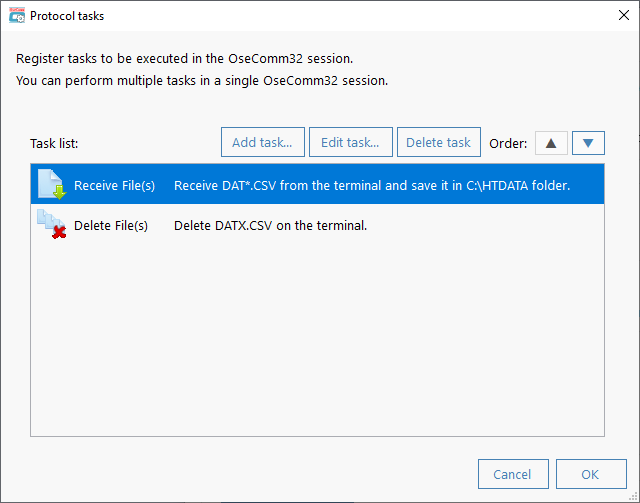
- Task group:
-
Click Add Task to add a protocol task. The added protocol task will be registered in the [Task List].
There are the following types of protocol tasks:
- File reception
- Save the file on the connected device to your PC.
Set the details in [File reception].
- Send file
- Sends files on your PC to the connected device.
Set the details in [File Send].
- Delete file
- Deletes files on the terminal.
Set the details in [Delete file].
- Date and time settings
- Sends the PC date and time to the terminal and sets the terminal date and time.
- [Edit task]:
- Edit the protocol task selected in the task list.
- [Delete task]:
- Deletes the protocol task selected in the task list.
- Order:▲:
- Replaces the selected task with the task one step above.
- Order:▼:
- Replaces the selected task with the task one step below.
Receive file
Set the details of the "File Reception" protocol task.
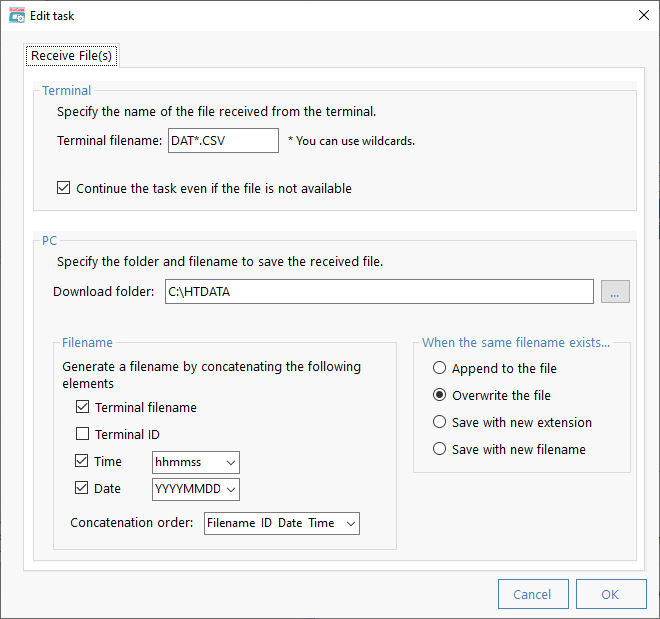
- Terminal file name:
- Specify the file name on the terminal to receive. Wildcards are allowed.
- Continue task when file not found:
- Continues subsequent tasks if file reception fails.
- Incoming folder:
- Specify the folder on the PC side to save the received file.
- When there are files with the same name...:
- If a file with the same name already exists in the folder where you save the received file,
- Append to file:
- Append to an existing file.
- Overwrite file:
- Overwrites an existing file.
- Change extension and save: Change the
- extension to a value between .000 and .999 and save.
- Rename and save file:
- Append numbers up to 9999 to the file name and save.
- File name:
- Specify the file name on the PC side to save the received file.
If you do not select any item, the file will be saved with the terminal file name.- Terminal file name:
- File name on terminal
- Terminal ID:
- ID number specified in the terminal application
- Time:
- Time the file was received. Specify the format using the pull-down menu on the right.
- Date:
- Date the file was received. Specify the format using the pull-down menu on the right.
- [Concatenation order:]:
- When multiple items are selected, specify the order in which the strings of the items are concatenated in the pull-down menu.
Send file
Set the details of the "File Send" protocol task.
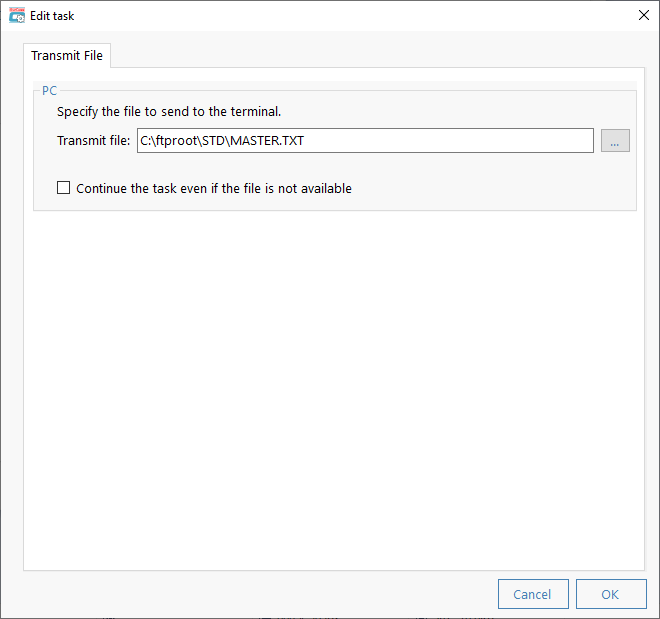
- Send file:
- Specify the file to send.
- Continue task when file not found:
- Continues subsequent tasks if file sending fails.
Delete file
Set the details of the "File Delete" protocol task.
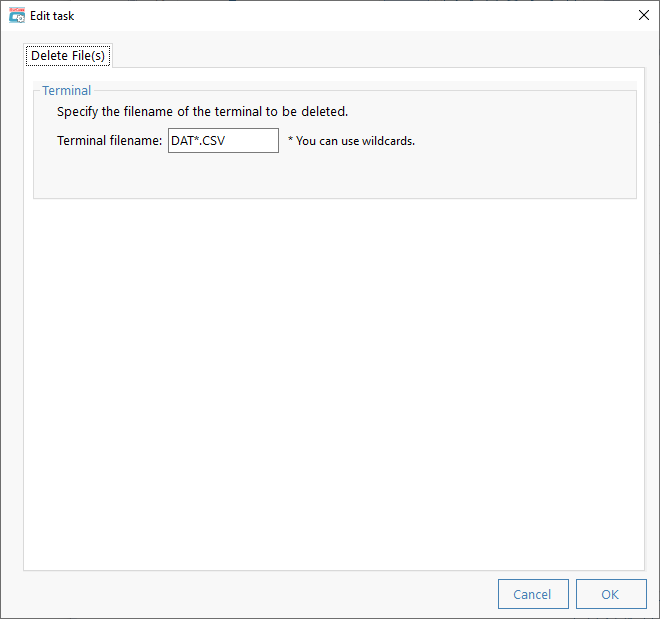
- Terminal file name:
- Specify the file name of the terminal to be deleted. Wildcards are allowed.
Last updated: 2025/01/23